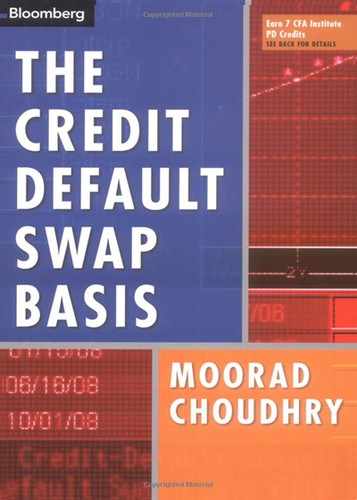APPENDIX III
Market-Implied Timing of Default from CDS Prices
The premium payable on a credit default swap (CDS) contract is an explicit valuation of default risk.1 Given that the CDS has a specified fixed term to maturity, it is possible by applying break-even analysis to extract a market-implied timing of default for the reference credit in question. This is done by calculating the amount of time that has to elapse before the premium income on the CDS equals the recovery value. By definition therefore, we require an assumed recovery rate to perform this calculation.
When a credit reference shows signs of distress, the CDS market begins to reflect this by marking higher the price of a CDS written on that name. This implies the timing of the default event. For instance, assume that recent market sentiment concerning ABC PLC suggests that it is about to be downgraded to sub-investment-grade status, and that default is now a high possibility. As a result, 5-year quarterly-in-arrears CDS for ABC PLC rises in price and is now quoted at 2,300 basis points (bps). The recovery rate is expected to be 30% of the company value in the event of default occurring. Given this information, it is possible to get an approximate idea of when the market anticipates a default.
FIGURE AIII.1 Default timing calculation, 5-year CDS
The calculation is shown in FIGURE AIII.1, an Excel spreadsheet used to obtain the break-even point value.2 Cell H10 establishes the difference between the recovery amount and the time-weighted premium income. In this case, the time weighting is quarterly, which is common for most CDS contracts. Initially, this value will not be equal to zero. To establish the (undiscounted) break-even point, we apply the “Goal Seek” function. We set the difference in H10 to zero by changing the value in cell D12. Cell D13 converts the number of periods back into years.
In our example, we have a 5-year CDS of £ 20 million trading at 2,300 basis points spread. £ 4.6 million would be paid each year for default protection. Assuming a 30% recovery rate, the recovery in the event of default is expected to be £ 6 million. Ignoring the necessary discounting process, the £ 6 million will be received as premium in approximately 1.3 years. If this calculation is correct, then selling protection via the CDS will bring in premium income until the default occurs. FIGURE AIII.2 shows the Excel formulas used in Figure AIII.1.
FIGURE AIII.2 Excel spreadsheet formulas used in Figure AIII.1
This type of trading has occurred in a number of lower-rated market sectors. Default timing risk can be seen as a means of achieving diversification of premium income within a portfolio.


